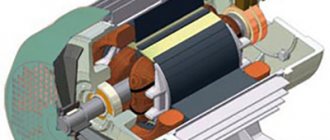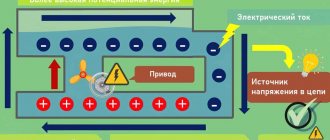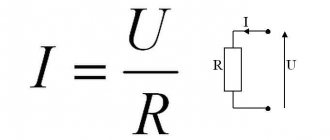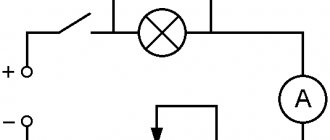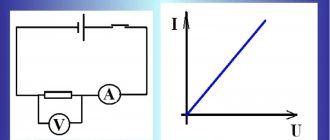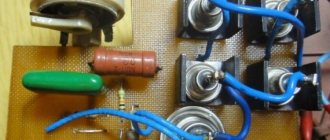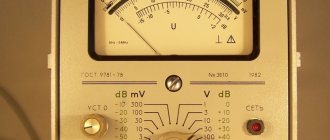What is voltage
Therefore, voltage is measured in similar quantities, that is, in volts.
And voltage is the potential difference between two points in a circuit. In addition, these potentials are considered only in an electrostatic field. It turns out that if you and I move the charge to 1 coulomb and point n. 1 to point n. 2, we will also do 1 Joule of work, provided that the potential difference between the points is 1 Volt.
It seems to be the same, but in the case of voltage, the presence of an electrostatic field is a prerequisite. Where did this come from? Thus, the source of this field is the EMF source connected to the circuit.
The image clearly shows the difference between EMF and voltage. On the right side, the liquid moves due to pressure (tension), and on the left side due to the work of external forces (electromotive force).
It turns out that if we take some galvanic element, for example, a battery, and measure its voltage with a multimeter without a connected load, we will get the EMF value.
If we create a closed circuit into which any load is connected, then by measuring the voltage at the same terminals of the battery, we will already see the voltage and it will be slightly less than the EMF value.
This is due to the fact that there is an internal resistance inside any EMF source, and when we connect a load, the voltage drop occurs not only at the ends of the load, but also at the internal resistance of the EMF source.
If you liked the article, please like it and thank you for your attention.
How does EMF differ from voltage?
When studying physics, we come across concepts such as EMF, which is short for electromotive force and voltage. Both quantities are measured in volts, which is confusing. After all, if quantities have the same unit of measurement, then the quantities themselves, logically, should be the same.
In practice, the concepts of EMF and voltage are equated. This action is not entirely correct from a physical point of view, and if in some cases it saves and allows you to solve the problem, in others it will become a problem and lead to incorrect perception. EMF can be equated to voltage, but not in a physical sense.
To understand these differences, we must first recall the definitions of the concepts in question.
The definition given in the textbook, as well as in Wikipedia, is as follows:
Electric voltage is a scalar physical quantity, the value of which is equal to the work done by the effective electric field when a single test electric charge is transferred from point A to point B.
This statement is difficult to understand for a person who has forgotten everything or is just learning the basics of the theory. In practice, to explain what voltage is, the image is more suitable:
If we compare a conductor to a pipe through which water flows, the voltage will be the same as the pressure of the water. A lot or a little water can flow into one tube. When there is little water, the voltage is low. There is a lot of water - the voltage is high. But the amount of water is already current. From these considerations it can be concluded that the stress can be compared with the pressure at a point on the pipe wall.
Now about the definition of EMF. This is also not very convenient."
Wikipedia and textbooks formulate it this way:
Electromotive force (EMF) is a scalar physical quantity that characterizes the work of external forces acting in quasi-stationary DC or AC circuits. In a closed conducting circuit, the EMF is equal to the work of these forces to move one positive charge throughout the circuit.
From the complex definition, it is not entirely clear that we are talking about a closed electrical circuit in which there is a current source. But there is a difference. In one case, this is the work of the electric field to transmit a test charge (voltage), and in the other, it is the work of external forces to move the charge throughout the circuit (EMF).
External forces are non-electrostatic forces. They can be very different. For example, in a battery they arise due to the energy of chemical reactions between electrodes and electrolytes, and in a generator - due to the mechanical energy of rotation of the generator rotor. Let's say we rubbed a comb on a wool sweater. This is a fact of friction and a fact of manifestation of the work of external forces. Well, as a result, an indictment was formed. The logic is the same.
For simplicity, we can say that EMF is the ability of a current source to create a potential difference in a circuit.
Electric current, as you probably already understood from the logic of determining voltage, is often compared to a plumbing system. Let's resort to comparison.
In order for water to circulate in a pipe equivalent to our circuit, a pump is needed. This pump is a source of current, and EMF is the ability of such a pump to create pressure in the pipeline. There is such a thing as water pressure. It is she who is best suited for this comparison.
Returning to the comparison of voltage with higher water, the voltage will be the pressure on the pipe, and the pressure of the water providing that pressure will be the emf.
The pump creates water pressure, which creates pressure. The current source in the circuit creates a potential difference that provides voltage. The ability to create voltage is electromotive force. Or we can say that the cause of voltage is electromotive force. Without EMF, there is no electric current, which means there can be no voltage.
It turns out that direct matching of EMF and voltage is the wrong technique. After all, the difference between electromotive force and voltage is that voltage is the “working effect” of electromotive force.
What is EMF
What is EMF, do you think? I'll tell you now!
Electromotive force (EMF) is also measured in Volts, like voltage.
Let's take a device that measures volts (voltmeter), a battery and take a measurement.
The device shows 1.5 Volts and this is not voltage, but electromotive force (EMF).
Now let’s connect the light bulbs to the battery.
Measuring voltage in various parts of an electrical circuit.
We noticed that on one light bulb the voltage (not EMF) is 1 Volt, and on the other 0.3 Volts
The voltage on the light bulbs depends on their power. Power is measured in Watts.
Power=Voltage*Current (P=U*I)
The higher the power of the light bulb, the higher the voltage will be on it.
If our battery is 1.5 volts = 1 volt +0.3 volts = 1.3 volts, where did the 0.2 volts go? The battery also has its own internal resistance, so that’s where they went.
Comparison with potential difference
Electromotive force and potential difference in a circuit are very similar physical quantities because both are measured in volts and are determined by the work done to move a charge. One of the main semantic differences is that etc. C. (E) is caused by the transformation of a certain energy into electrical energy, while the potential difference (U) realizes electrical energy in other forms. The rest of the differences look like this:
- And transmits energy throughout the chain. U is a measure of the energy between two points on a diagram.
- E causes U, but not vice versa.
- E is induced in electric, magnetic and gravitational fields.
- Concept, etc. Applies only to the electric field, and potential difference applies to the magnetic, gravitational and electric fields.
The voltage at the terminals of the power supply, as a rule, differs from the source emf. This is due to the presence of internal resistance of the source (electrolyte and electrodes, generator windings). The formula connecting the potential difference and the emf of the current source is U = E-Ir. In this expression:
- U is the voltage at the source terminals;
- r is the internal resistance of the source;
- I is the current in the circuit.
EMF. Ohm's law for a complete circuit
The author of the article is a professional tutor, author of textbooks for preparing for the Unified State Exam Igor Vyacheslavovich Yakovlev
Topics of the Unified State Examination codifier: electromotive force, internal resistance of a current source, Ohm's law for a complete electrical circuit.
Until now, when studying electric current, we have considered the directional movement of free charges in an external circuit
, that is, in the conductors connected to the terminals of the current source.
As we know, positive charge:
• goes into the external circuit from the positive terminal of the source;
• moves in an external circuit under the influence of a stationary electric field created by other moving charges;
• comes to the negative terminal of the source, completing its path in the external circuit.
Tester operating modes
The operation of the multimeter and its modes are regulated by a switch. Its upper vertical position means that the device is turned off. A reversal in any other direction indicates a regime change and is indicated as follows:
DCV or V with a straight line displays the DC voltage value;- ACV or V with wave indicates that AC voltage is being measured;
- Ω - symbols of this type indicate resistance;
- And with a straight line or combination of letters, DCA is a measure of direct current (amps);
- And with a wave, this indicates that the multimeter measures the strength of alternating current; not all devices have it;
- the sign indicating a diode indicates that diodes can sound;
- hFE shows that it is possible to measure the characteristics of transistors.
All results are displayed on the tester screen in seconds, accurate to hundredths, indicating the value of the selected indicator.
The designation of alternating current on any multimeter can be viewed in the form of AC symbols (alternating current). Therefore, ACA is AC power, ACV is AC voltage. This is a current that changes direction a huge but constant number of times in 1 second. In home networks, the frequency change is 50 Hz.
EMF in everyday life and units of measurement
Other examples can be found in the practical life of any ordinary person. Common things like small batteries and other miniature batteries fall into this category. In this case, the working EMF is formed due to chemical processes occurring in constant voltage sources.
When this happens at the terminals (poles) of the battery due to internal changes, the cell is fully ready for use. Over time, the EMF decreases slightly, and the internal resistance increases significantly.
As a result, if you measure the voltage on an unconnected finger battery, you will see 1.5V (or so) is normal, but when there is a load connected to the battery - say you installed it in some device - it does not work.
Why? Because if we assume that the internal resistance of the voltmeter is many times greater than the internal resistance of the battery, then you have measured its emf. When the battery began to supply current to the load, its terminals became not 1.5 V, but, for example, 1.2 V - the device does not have enough voltage or current for normal operation. It was this 0.3V that reached the internal resistance of the galvanic element. If the battery is very old and its electrodes are destroyed, there may be no electromotive force or voltage, such as zero, at the battery terminals.
Ohm's law for a complete circuit
After reducing by we get:
So we found the current in the circuit:
Formula (4) is called Ohm's law for a complete circuit
.
Due to the small internal resistance, the short circuit current can be quite large. For example, a AA battery gets so hot that it burns your hands.
Knowing the current strength (formula (4)), we can find the voltage across the resistor using Ohm’s law for a section of the circuit:
This voltage is the potential difference between points and (Fig. 2). The potential of the point is equal to the potential of the positive terminal of the source; the potential of the point is equal to the potential of the negative terminal. Therefore, voltage (5) is also called voltage at the source terminals
.
The meaning of this result is simple: if the source is not connected to the circuit, then a voltmeter connected to the poles of the source will show its EMF
.
Electromagnetic induction (self-induction)
Let's start with electromagnetic induction. This phenomenon is described by Faraday's law of electromagnetic induction. The physical significance of this phenomenon is the ability of an electromagnetic field to induce an electromagnetic field in an adjacent conductor. In this case, either the field must change, for example, in the magnitude and direction of the vectors, or move relative to the conductor, or the conductor must move relative to this field. In this case, a potential difference occurs at the ends of the conductor
There is another phenomenon that is similar in meaning - mutual induction. Since changing the direction and strength of current in a coil induces an emf at the terminals of an adjacent coil, it is widely used in various fields of engineering, including electrical and electronic. This is the basis of the operation of transformers, in which the magnetic flux of one winding induces current and voltage in the second.
In electronics, a physical effect called EMF is used in the production of special AC converters that provide the desired RMS (current and voltage) values. Thanks to the phenomena of induction and self-induction, engineers were able to develop many electrical devices: from a conventional inductor (choke) to a transformer.
The concept of mutual induction applies only to alternating current, during the flow of which the magnetic flux changes in a circuit or conductor.
Electric current in a constant direction is also characterized by other manifestations of this force, for example, the potential difference at the poles of a galvanic cell, which we will talk about later.
What is tension?
There is a difference in electrical states at the poles (terminals) of the source. There is an excess of electrons at the negative pole and a shortage of electrons at the positive pole. In a closed current circuit, electrons move from the negative half to the positive half through conductors and devices. The difference in electrical potential is called electrical voltage. Electric voltage is equal to the amount of work performed by electric force when moving a charge from one point in the field to another and this charging. Electrical voltage is measured in volts. The voltage meter is called a voltmeter.
What is the difference between electromotive force (EMF) and voltage
Voltage is the result of electric current passing through a circuit. This occurs in areas of resistance to the path of electrical current. All matter has resistance (except superconductors), so the entire path of electric current has a voltage that pushes it along the circuit. Somewhere more, somewhere less, it depends on the strength of a particular area.
Electromotive force (EMF) is the force that moves charges in a closed circuit.
Let's take an example by analogy with a closed circuit.
We supply water through a pipe. This will create pressure on the pipe walls. And where does this pressure come from? Of water? No. This pressure is the part of the head that moves the water through the tube. And pressure is EMF. The stress in this example is the pressure on the pipe walls. That is, water itself will not flow through the pipe if there is no pressure. And the pressure in the tube will not rise if there is no pressure. Of course, this example is not quite so precise, but it makes the point much easier to understand.
The sum of all voltages in the circuit = EMF. This is Kirchhoff's second law. Electromotive force is what causes electrons to move through a circuit.
In EMF, external forces (chemical reactions, solar energy, mechanical work, etc.) actually work by moving charge along a closed circuit from negative to positive potential. Simply put, an EMF is a facility for generating electricity.
And voltage is part of the EMF in closed sections of the circuit. Voltage, unlike EMF, does electrical work to move charges along a circuit. For example, with a serial connection it can be different everywhere. And this is apparently due to the fact that there are obstacles in the path of electrons. And the stronger this obstacle, the more energy the field must expend to move the charge.
That is, what voltage drop (part of the EMF) will be across the load depends on the electric current and resistance: U = RI.
And the EMF, in turn, is the source of all voltages in the circuit. Without EMF there is no electric current. And also tension.
Simply put, EMF is distributed evenly throughout an electrical circuit in the form of voltage when the circuit is closed. When a circuit is not closed, there is no voltage in it. Voltage only does electrical work to move charges through a circuit. But without closing the circuit there is no voltage.
The voltage itself cannot be measured without closing the circuit. It is impossible to measure an open source with a voltmeter or multimeter. Simply because the device closes the circuit and measures the current flowing through it. This current is multiplied by the selected shunt (resistance) to produce the measured voltage.
There is no contradiction here. The source potential difference (EMF) moves charges along the circuit. This work is distributed over all sections of the circuit depending on the resistance. And only when the circuit is closed and electrons can flow through the circuit (they have somewhere to go) does the voltage increase. Therefore, it is impossible to measure voltage without closing the circuit. And it is also theoretically impossible to calculate the voltage without closing the circuit. To find out the voltage, you need to know the power or current. Current or power data can only be found after the circuit is closed, also theoretically.
Why then is voltage indicated on batteries or accumulators, or any other source, and not EMF? The fact is that in an ideal source there is no internal resistance. Internal resistance can be contacts, materials, chemical reactions, reactions.
And because they have resistance, when electric current flows through them, voltage appears across them. Therefore, the volts at the terminals of the current source are called voltage, not electromotive force.
Only superconductors can have virtually zero resistance.
This confusion of concepts is often misleading, for example: “If voltage is a consequence of the passage of current, then why is voltage the cause of the movement of charges?” The reason for the passage of electric current in a circuit is EMF. The consequence of the passage of current through the circuit in hotel areas is the occurrence of voltage. The voltage of the entire circuit is equal to the emf.
For example, the electromotive force of a battery is 4.88 V, and the voltage at its terminals is 4.85 V. Is it worth using the electromotive force values if there is still a small percentage of volts left at the source terminals?
In everyday life it is not customary to use the term EMF; there is no need for it. But if you're designing circuits, assembling them, or soldering them, the resistance of the power supply is a very important parameter. Adjusting the resistance affects the entire operation of the circuit. And this applies not only to power supplies, but also to all analog and digital equipment.
Relativity and stress
Let's say there are three balls.
One of them is charged +15 V, the second + 5 V and the third 0. Which one will be more positive and which one will be negative? All matter is made up of molecules. Molecules, in turn, are made up of atoms.
Atoms have different properties, but each has a proton and an electron, and almost all have a neutron in addition to the above. What determines the charge of an atom? This is a compensation of the charges of electrons and protons. The electron is a minus and the proton is a plus. If there are not enough electrons, the atom is positively charged; if there is an excess, it is negatively charged. Why is this happening? It is a result of the physical properties of atoms, the environment, and interactions with other materials. For example, valence electrons can leave atoms, making them positive.
The third ball, which is neutral (with protons and electrons canceling out), will be negative with respect to the first two. Because compared to these balls, this ball has more electrons. Positive people tend to accept it and are drawn to it. What about two positive balls? Those who are less positive become negative. If you subtract the value of the second ball from the others, you get the following situation: the first ball has +10V, the second - 0V, and the third -5V.
Compared to the first ball, the other two became negative, and the potential difference increased. Therefore, if two bodies are positively (or negatively) charged differently, they may be opposite to each other.
This does not contradict Coulomb's law. Two positive (or negative) balls repel each other if they have the same charge. That is, if there are two balls +5V and +5V, they will begin to repel each other, but if they have +4V and +5V, they will begin to attract until they cancel each other out with charges of the same value (+4.5V). However, compared to 0, positively charged bodies remain.
Practice
We have already mentioned that in everyday life an electric field appears when you take off woolen or synthetic clothes and sparks jump between the hair and wool, when you rub a plastic ruler and hold it over small pieces of paper, and they are attracted, and so on. But these are not normal technical examples.
In conductors, the slightest electric shock causes the movement of charge carriers and their redistribution. In dielectrics, since the band gap in these substances is large, EP will cause the movement of charge carriers only in the event of a breakdown of the dielectric. In semiconductors, the action is between the dielectric and the conductor, but it is necessary to overcome the small band gap by transferring energy of the order of 0.3...0.7 eV (for germanium and silicon).
From what every home has are electronic household appliances, including power supplies. They have an important part that works thanks to the electric field - this is a capacitor. In it, charges are held on plates separated by a dielectric, precisely due to the operation of the electric field. In the picture below you see a conventional image of the charges on the capacitor plates.
Another application in electrical engineering is field effect transistors or MOS transistors. Their name already mentions the principle of operation. In them, the operating principle is based on a change in the DRAIN-SOURCE conductivity under the influence of a transverse electric field on the semiconductor, and in MOS (MOS, MOSFET - the same thing) the gate is completely separated by a dielectric layer (oxide) from the conducting channel, so that the influence of GATE currents -SOURCE is impossible by definition.
Another application that has already passed away in everyday life, but is still “alive” in industrial and laboratory technology, is cathode ray tubes (CRTs or so-called picture tubes). Where one of the device options for moving the beam across the screen is an electrostatic deflection system.
To put it in simple terms, there is a gun that radiates (emits) electrons. There is a system that deflects this electron to the desired point on the screen to obtain the desired image. A voltage is applied to the plates, and the emitted flying electron is affected by Coulomb forces and, accordingly, an electric field. Everything described happens in a vacuum. Then high voltage is applied to the plates, and to form it, a horizontal scan transformer and a flyback converter are installed.
The video below briefly and clearly explains what an electric field is and what properties this special type of matter has:
The main differences between EMF and voltage
Electromotive force is called voltage, which, according to its definition, is the ratio of the work done by external forces in relation to the transfer of a positive charge directly to the very value of this charge. Voltage, in turn, is already the ratio between the work of the electric field in relation to the transfer of the so-called electric charge. So, for example, if your car has a battery, its emf will always be 13 volts. Well, if you also connect a voltmeter, a device designed to measure voltage, to the above-mentioned device with the headlights on, the latter figure will be much lower than 13 W. This trend, perhaps a little strange, is due to the fact that in the battery, the action of a chemical reaction is perceived as external forces. At the same time, the car also has a generator that produces simple electric current when the engine is running.
In light of the above, we can talk about the main distinctive features of EMF and voltage:
- The EMF will depend on the source itself. Well, if we talk about voltage, then its indicator directly depends on what kind of connection and what current is currently flowing through the circuit.
- EMF is a physical quantity necessary to characterize the work of non-Coulomb forces, and voltage characterizes the work of the current in relation to the movement of the charge by the latter.
- These concepts are also different because electromotive force refers to magnetic induction, while voltage is more commonly used in relation to direct current.
Electrical circuit efficiency
It's not hard to see why a resistor is called a payload. Imagine it's a light bulb. The heat generated by a light bulb is beneficial
, since thanks to this warmth the light bulb fulfills its purpose - giving light.
A certain amount of heat is also released at the current source:
The total amount of heat released in the circuit is equal to:
Electrical circuit efficiency
is the ratio of useful heat to total heat:
How to determine the value of alternating voltage in the network
An important point when determining alternating voltage is that the multimeter probes are connected in parallel to the device being measured. This is because voltage itself represents the potential difference between two points.
The same principle can be used as in the case of alternating current. Adjust the range of values from maximum to minimum, keeping in mind the position of the sensors.
For example, you can use a standard battery to measure AC voltage. The switch is set to the appropriate mode, the interval is set. In this case, the probes touch the battery in parallel on both sides. And you can immediately see how the voltage value of the element under study is displayed on the screen.
The situation is the same with constant voltage, but you just need to remember to set the switch to the correct mode.
Regardless of the model and specific operation of the multimeter, it is important to follow fire safety rules and handle electrical devices correctly without endangering your health.
Electromotive force (EMF) of the energy source
To maintain electric current in a conductor, an external power source is required that continuously creates a potential difference between the ends of that conductor. Such energy sources are called electrical energy sources (or current sources). Sources of electrical energy have a certain electromotive force (abbreviated EMF), which creates and maintains a potential difference between the ends of the conductor for a long time.
It is sometimes said that EMF creates an electric current in a circuit. It is necessary to remember that this definition is conditional, since we have already established above that the cause of the appearance and existence of an electric current is an electric field.
An electrical source does some work by moving electrical charges throughout a closed loop. The unit of measurement of electromotive force is the volt (abbreviated volt is denoted by the letter B or V - the Latin “ve”). The emf of a source of electricity is equal to one volt if, when moving a coulund of electricity throughout a closed loop, the source of electricity performs work equal to one joule:
Electromotive force (EMF) of an energy source.
In practice, both larger and smaller units are used to measure EMF, namely:
- 1 kilovolt (kV, kV) is equal to 1000 V;
- 1 millivolt (mV, mV), equal to one thousandth of a volt (10-3 V),
- 1 microvolt (μV, μV), equal to one millionth of a volt (10-6 V).
Obviously, 1 kV = 1000 V; 1 V = 1000 mV = 1,000,000 μV; 1 mV = 1000 µV.
Currently, there are several types of electricity sources. For the first time, a galvanic battery was used as a source of electricity, consisting of several circles of zinc and copper, between which skin soaked in acidified water was placed. In a voltaic battery, chemical energy was converted into electrical energy (more on this in Chapter XVI). The galvanic battery got its name from the Italian physiologist Luigi Galvani (1737-1798), one of the founders of the theory of electricity.
Numerous experiments on the improvement and practical use of galvanic batteries were carried out by the Russian scientist Vasily Vladimirovich Petrov. At the beginning of the last century, he created the largest galvanic battery in the world and used it for a series of brilliant experiments. Sources of electrical energy that work on the principle of converting chemical energy into electrical energy are called chemical sources of electrical energy.
Another important source of electricity, widely used in electrical and radio engineering, is the generator. In generators, mechanical energy is converted into electrical energy. In chemical power sources and generators, electromotive force manifests itself in the same way, creating a potential difference at the terminals of the source and maintaining it for a long time.
These terminals are called the poles of the electrical energy source. One pole of an electrical energy source has a positive potential (no electrons), is indicated by a plus sign (+) and is called the positive pole.
The other pole has a negative potential (excess electrons), indicated by a minus sign (-), and is called the negative pole. From sources of electrical energy, electrical energy is transmitted through wires to its consumers (electric lamps, electric motors, electric arcs, electric heating devices, etc.).
Summary
- The quantity that adequately represents the generator as an element of an electrical circuit and quantitatively characterizes its ability to maintain current in the circuit and convert other forms of energy into electrical energy is called electromotive force. In order for a source to have a pole potential difference, electrons must "move" from one pole to the other, i.e., a charge separation operation is required. The work done on a charge block by an external force by dividing charges on a source of electric current is called electromotive force. Electromotive force (EMF) has a voltage dimension (voltage unit) and is also called the internal source voltage (U0). The electromotive force is the same size as the potential difference between the positive and negative connections of the generator when it is in standby mode.
- The potential difference between two points in an electric field is called voltage, and unity is also equal to voltage. Electrical voltage causes electrons to flow in an electrical circuit to the (-) negative pole with excess electrons to the (+) positive pole with an electronic defect - electrons move from the (-) half to the (+) pole.
Housing elements
Since digital models are becoming more and more popular, the basic designations and characteristics of multimeters will be discussed using their example.
They are equipped with a liquid crystal display on which the measured values are displayed. Just below is a switch that rotates around its axis. Indicates the selected measurement type and range.
2 probes with wires are connected to the sockets on the multimeter body: red or positive, black or negative.
The negative probe is always connected to the connector labeled "Ground" or "COM". Plus connects to any other connector.
It should be noted that there can be 2, 3 or 4 connectors. Their number depends on the model and manufacturer. However, even in such multimeters, the socket for connecting only the positive probe can be changed, the negative one remains in the same place.
What is EMF and why is it often confused with voltage?
EMF, or electromotive force, as it is usually called in many textbooks, is a physical quantity that characterizes the work of any external forces present in direct or alternating current sources. If we are talking about a closed conducting circuit, then it should be noted that in this case the EMF will be equal to the work of forces to move a single positive charge along the above circuit. Electromotive force and voltage are confused - for good reason. As you know, these two concepts are today measured in volts. In this case, we can talk about EMF in any part of the target, because in fact this is a special work of external forces that do not act in the entire circuit, but only in a specific area.
The fact that the EMF of a galvanic cell involves the work of external forces working when moving a single positive charge from one pole to a completely different one deserves special attention on your part. The work of these external forces directly depends on the shape of the trajectory, but cannot be expressed through the potential difference. The latter is due to the fact that external forces are not potential. Even though voltage is one of the simplest concepts, many consumers do not fully understand what it is. If you don't understand this either, we feel it necessary to give you some examples.
For clarity, let’s take an ordinary water tank. A regular pipe will have to come out of such a container. Therefore, the height of the water column or pressure, in simple words, will represent voltage, while the flow of water will be electrical current. In view of the above, the more water supplied to the tank, the higher its pressure and voltage, respectively.
Third party force
Nevertheless, current flows through the circuit; therefore, there is a force that “pulls” the charge through the source despite the resistance of the electric field of the terminals (Fig. 1).
Rice. 1. Third party force
This force is called a third party force
;
It is thanks to it that the current source functions. The external force has nothing to do with the stationary electric field - it is said to be of non-electrical
origin; in batteries, for example, it arises due to the occurrence of appropriate chemical reactions.
Let us denote by the work of an external force to move a positive charge q inside the current source from the negative terminal to the positive. This work is positive, since the direction of the external force coincides with the direction of charge movement. The work of an external force is also called the work of a current source
.
There is no external force in the external circuit, so the work done by the external force to move the charge in the external circuit is zero. Therefore, the work of an external force to move a charge around the entire circuit is reduced to the work of moving this charge only inside the current source. Thus, this is also the work of an external force to move charge throughout the circuit
.
We see that the external force is non-potential - its work when moving a charge along a closed path is not zero. It is this non-potentiality that allows the electric current to circulate; a potential electric field, as we said earlier, cannot support a constant current.
This quantity is called electromotive force
(EMF) of the current source. As you can see, EMF is measured in volts (V), so the name “electromotive force” is extremely unfortunate. But it has long been ingrained, so you have to come to terms with it.
When you see the inscription on the battery: “1.5 V”, then know that this is exactly the EMF. Is this value equal to the voltage created by the battery in the external circuit? It turns out not! Now we will understand why.
Connection sequence
It is important to note that when starting to measure the AC level, it is not at all necessary to observe the polarity of connecting the probes. If its value is negative, a minus sign will appear in front of the numbers on the screen.
We put the switch of the multimeter that measures this indicator in the appropriate position and set the measurement range.
The choice of measurement limits should be approached as responsibly as possible. If the measured current significantly exceeds the selected range, it may cause the fuse or, worse, the entire multimeter to blow.
Pay attention to the choice of connector (socket). Below should be the maximum current you want to measure. 10A means that up to 10A of current is measured (quite high).
To set up the measurement process, first set the switch to the maximum permissible range of values, insert the probe plugs into the sockets. Also reduce the level if necessary.
To measure AC or DC current, the multimeter must be connected in series with the load (flashlight, lamp, cooler, radio circuit, etc.). This is the basic rule for all electrical measuring instruments. That is, to measure current, the multimeter is connected “into the open” of the circuit.
Let's sum it up:
What is electromotive force (EMF) - this is a physical quantity that characterizes the work of external forces in current sources (batteries, generators, etc.). EMF shows us the work of a current source in transferring charge through the entire circuit.
And voltage shows us the work of charge transfer in a section of the circuit.
What is tension in simple words? It is an external force that moves our ball in the example shown above.
And in electricity, it is the force that moves electrons from one atom to another.
Let me give you another example of what electrical voltage is:
Imagine that you can lift a stone weighing 50 kg, that is, your lifting force is 50 kg (in electricity, this is electromotive force). You are walking and on your way there is a stone weighing 20 kg, you take it and carry it 10 meters. You spent a certain amount of energy moving this stone (in electricity, this is voltage). The next stone already weighs 40 kg and to move it from one point to another you will spend more energy than you spent moving a stone weighing 20 kg. You always have the same lifting force (in electricity, this is EMF), but depending on the weight of the stone, you always spend a different amount of energy (in electricity, this is voltage). Those. On each leg of the journey you have different stress.
I hope you understand what electrical voltage is!
From electrostatics to electrokinetics
In the late 18th and early 19th centuries, the work of scientists such as Coulomb, Lagrange and Poisson laid the mathematical foundation for the determination of electrostatic quantities. Progress in the understanding of electricity at this historical stage is obvious. Franklin had already introduced the concept of “amount of electrical matter,” but so far neither he nor his followers have been able to measure it.
After Galvani's experiments, Volta tried to find evidence that the animal's "galvanic fluids" were of the same nature as static electricity. In his search for the truth, he discovered that when two electrodes of different metals come into contact through an electrolyte, they both become charged and remain charged despite the circuit being completed by a load. This phenomenon did not correspond to existing ideas about electricity, because electrostatic charges in this case had to recombine.
Volta introduced a new definition of the force acting in the direction of separating charges and holding them in this state. He called it an electric motor. This explanation for describing the operation of the battery did not correspond to the theoretical foundations of physics at that time. In the Coulomb paradigm of the first third of the 19th century, etc. Volta was determined by the ability of some bodies to generate electricity in others.
Ohm made a major contribution to the explanation of the operation of electrical circuits. The results of a series of experiments led him to the construction of the theory of electrical conductivity. He introduced the meaning of "voltage" and defined it as the potential difference between the contacts. Like Fourier, who in his theory distinguished between the amount of heat and temperature during heat transfer, Ohm created a model by analogy, relating the amount of charge transferred, voltage and electrical conductivity. Ohm's law did not contradict the accumulated knowledge of electrostatic electricity.
So, thanks to Maxwell and Faraday, existing explanatory models received a new field theory. This allowed the development of the concept of field-related energy for both static potentials and electromotive force. Key dates for the evolution of the EMF concept:
- 1800 - construction of the Volta galvanic battery;
- 1826 Ohm formulates his law for a complete circuit;
- 1831 - Faraday's discovery of electromagnetic induction.
